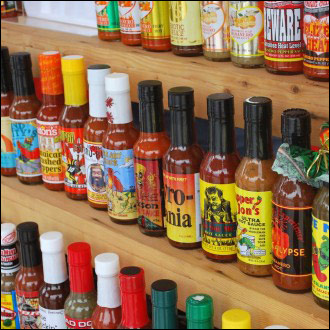 I don’t know about you, but just about any excuse to try out new hot sauces is a good one for me! Even though I’ve tasted innumerable spicy food products, I’m always on the lookout for “the next big thing”, or at least come across something with a slightly different spin on some classic flavor combinations.
I don’t know about you, but just about any excuse to try out new hot sauces is a good one for me! Even though I’ve tasted innumerable spicy food products, I’m always on the lookout for “the next big thing”, or at least come across something with a slightly different spin on some classic flavor combinations.
One very advantageous method to getting you and your fellow local chileheads to try some new hot sauces is to start your own hot sauce club. Not only will you be exposed to some potentially awesome fiery foods products with a hot sauce club, but you can meet some really great people in the process.
You may be asking yourself, “How do I create such a club for chileheads? What would we even do in such a gathering?” This handy guide on how to start a local hot sauce club will aide you and your spicy food friends to greater exposure to hot sauces as well as having a bit of fun in the process.
How to Start: Get the Word Out!
First, find a suitable location that is centrally located to most of the club members. Just by using your noggin, you can probably think of some places to meet with plenty of room for both congregating inside or and for parking. It could be someone’s residence, a member’s place of business after hours, or even a restaurant or bar and grill (they might be content with getting some business by selling your group beverages if you ask them what nights are the slowest for them).
You’re probably able to scrape together a few chilehead buddies by yourself just using word-of-mouth. To get a larger crowd, you can utilize the power of social networking. Virtually all major cities in the U.S. have social media groups that not only effectively harness the power of Twitter, Facebook, LinkedIn, Pinterest, and others, but hold regular get-togethers throughout the year. Join them, by a part of the community, and see if there are other like-minded chileheads and adventurous foodies.
What You’ll Need:
- Hot Sauces, Salsas, and Other Condiments
- A Large Table or Counter
- Disposable Spoons
- Paper Plates
- Score Sheets (see “How to Rate Each Hot Sauce” below)
- Pens/Pencils
- Toothpicks
- Testing Food (see “Find Appropriate Food with Which to Eat the Hot Sauce” below)
- Sour Cream (or other soothing dairy product to help with extreme burn in the mouth)
The hot sauces offered for tasting can be both brand new, unopened bottles of the peppery condiments or they can be previously-opened bottles that hot sauce club members have already eaten and enjoyed. Whatever the case, see if each member is able to bring at least a couple of bottles to share with the group. Hardcore sauce fans can find this a good way to help empty out the refrigerator by donating their used bottles for club tasting.
Find Appropriate Food with Which to Eat the Hot Sauce
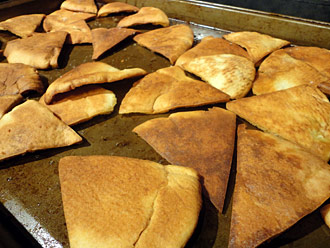 As some hot sauces can taste out of place by themselves on a spoon, you need a proper vessel on which to consume hot sauce. While some foods on the surface may sound like good parings, such as tortilla chips, you need to keep in mind that such things can contain heavy amounts of salt and can affect the overall flavor of the hot sauce. If your group is sampling chunkier salsas as opposed to pepper sauces, this may not be a bad route as one would expect an all-purpose salsa to go great with tortilla chips.
As some hot sauces can taste out of place by themselves on a spoon, you need a proper vessel on which to consume hot sauce. While some foods on the surface may sound like good parings, such as tortilla chips, you need to keep in mind that such things can contain heavy amounts of salt and can affect the overall flavor of the hot sauce. If your group is sampling chunkier salsas as opposed to pepper sauces, this may not be a bad route as one would expect an all-purpose salsa to go great with tortilla chips.
For straightforward hot sauces, I would suggest the following items to taste them on:
Try one of the following “plain” crackers: Water biscuits or table water crackers; Unsalted saltines; or Pita chips.
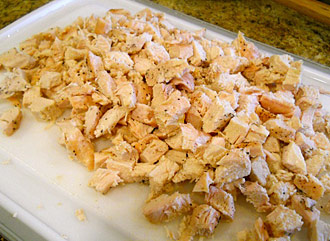 Some sauces go better with meat. If you can, have someone cook up a few chicken breasts and have them cut them up into small, 1/2 inch cubes. Using a toothpick, dab the chicken chunk into the sauce and enjoy.
Some sauces go better with meat. If you can, have someone cook up a few chicken breasts and have them cut them up into small, 1/2 inch cubes. Using a toothpick, dab the chicken chunk into the sauce and enjoy.
Perhaps order a cheese pizza. While this may seemingly go against my advice above to avoid heavily salty items (and ones with a potpourri of intermingling flavors), I’ve found that pizza is a near-perfect litmus test for most any table sauce – if it tastes good on pizza, then it’s a quality sauce. Be sure to bring a pizza cutter to slice up the pie into more manageable, bite-sized pieces, and then serve them up on toothpicks.
How to Organize the Hot Sauces for Tasting
There are a couple of different approaches you can take to organizing, dividing up and categorizing the hot sauces when setting them out on the table or counter when it’s finally time to taste them. At a glance, they can be organized these ways:
• By hot sauce club members who brought them in
• By type/style/flavor of sauce that it is: smoky, tangy, sweet, fruity, peppery, tropical, buffalo-style, Louisiana-style, southwest-style, chile pepper type, etc.
• By the heat level
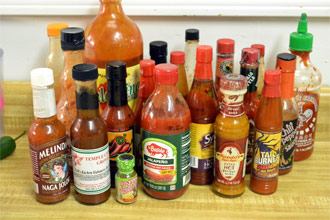 There is no right or wrong way to doing this, but let’s look at the positives and negatives of each one:
There is no right or wrong way to doing this, but let’s look at the positives and negatives of each one:
If you opt to divide them up by who brought each particular bottle of sauce, it makes for the quickest categorization because you don’t have to analyze each one beforehand. The downside is that you might not know what to expect at all and be unpleasantly surprised if someone gets a sauce outside of their realm of comfort or heat tolerance.
Organizing them by style and type of sauce? This method of categorization may do the trick especially if you are faced with an extensive array of sauces. But it also requires an intimate knowledge of the flavor profile of each and every product beforehand. And what if a sauce does not conveniently fall within one particular style or category?
Heat level is a smart way of grouping sauces together. We experienced chileheads often forget that there are novices who may be eager to taste many hot sauces but may not be acclimated to high amounts of heat during the beginning stages of their spicy exploits. A possible issue with this a similar predicament to organizing them by style and flavor profile – a prior knowledge of each sauce’s heat level is required. Not only that, but the overall spiciness can be very subjective – what may be a medium burn for me may be a ferocious fire on the tongue to someone else.
All that having been said, I would most likely shoot for arranging the hot sauces by heat level.
How to Rate Each Hot Sauce
Now that you have your fellow fiery foods aficionados in tow, your sauces ready for sampling and relatively flavor-neutral food to try them on, it’s time to get tasting!
But how do you go through and grade each one? You can be informal if you like, and simply let people try out the sauces randomly as they please. Or you can get very formal and technical and have each sauce club member all sample one before you advance to the next one.
One thing I would recommend is that you and your fellow sauce mavens keep notes or even a Score Sheet (as listed in the “What You’ll Need” section above). These can be done on your smartphone or handwritten notes, but I urge you to keep track of the following info:
Label and Bottle – Do the graphics look cool? Do they present the sauce in a positive and accurate light? Do they do the product justice? Would you notice this on a store shelf? Would it stand out from other bottled condiments?
Aroma – What does it smell like?
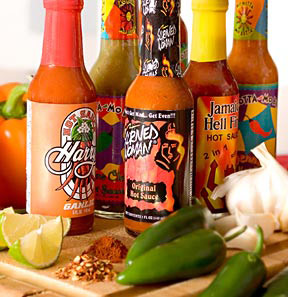 Texture and Appearance – Does the color look appealing? Can you see the individual ingredients? How does it pour from the bottle? Is it thin, medium, thick, pulpy, chunky, smooth, clumpy, or oily? Does it stick to food or run off? How does it appetizing on food?
Texture and Appearance – Does the color look appealing? Can you see the individual ingredients? How does it pour from the bottle? Is it thin, medium, thick, pulpy, chunky, smooth, clumpy, or oily? Does it stick to food or run off? How does it appetizing on food?
Taste – What flavors hit you first? Does it fit one particular flavor profile? Is it specific to one pepper style? Is the chile pepper taste dominant, or to the other components take center stage? Does it seem to be highly versatile, or play for a narrow audience or cuisine? Does the heat hit you immediately, or is the burn delayed? Is the overall taste bright, biting and powerful, or is it softer and subtle? Is there any residual aftertaste?
Heat – Is it a quick or sneaky heat? Where does the spiciness hit the mouth – a particular part of the tongue or back of the throat? How much hotness builds up after mass consumption?
Ingredients – what is the sauce made from? Is everything clearly laid out and listed? Does it pose any health or dietary concerns to you, especially if you are on a low/no-sodium or a gluten-free diet? What chile peppers are listed and do they somewhat accurately reflect what is advertised elsewhere on the label?
Company Info and Availability – While you probably won’t be able to easily find out who co-packs this product or see if it is private labeled, is the company well known to you and can you easily access their website? Also, where can you purchase this product? Can it be found at a brick and mortar shop, at a local farmer’s market, or only online? With this info, you can investigate other offerings that a particular sauce maker might have if you take a particular liking to them.
Just Do It!
Jump out there and simply make it happen. And just don’t think that you should limit yourself to the basic suggestions and guidelines I listed above. Feel free to experiment, innovate, and try other approaches. For instance, you can introduce homemade goods, such as your own custom-made hot sauces, BBQ sauces and salsa; or if you want to try your hand at having members cook up a spicy dessert or snack (think chile-infused cookies or fiery-seasoned popcorn) you may wish to do so.
Most anything that will allow you to share some laughs and camaraderie while enjoying some spicy and delicious food is encouraged.
